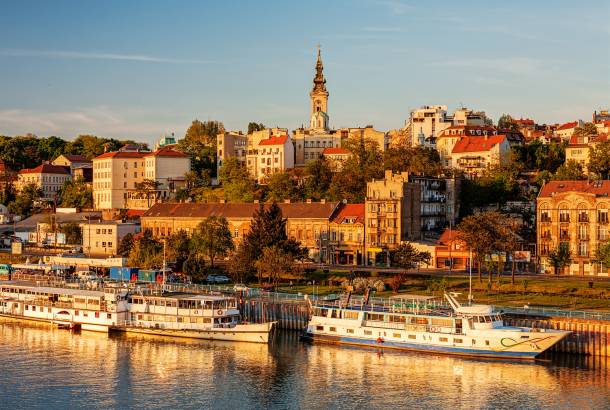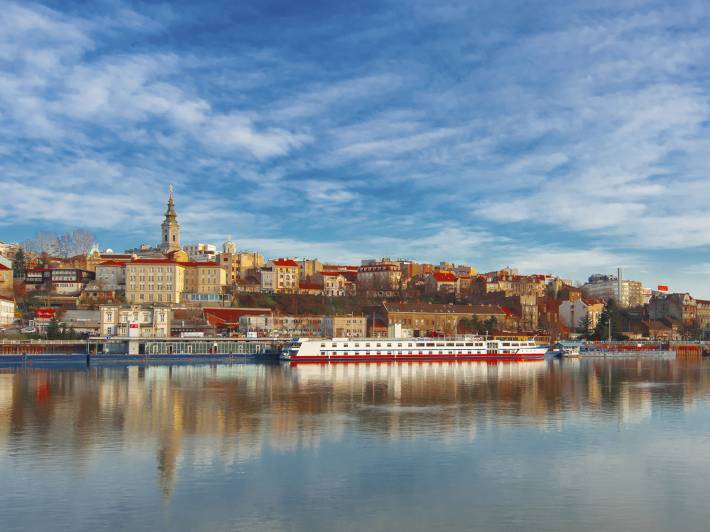
What vaccinations do I need for Serbia?
Consult your local health practitioner for advice on vaccinations before travelling to Serbia. Ensure you're up to date with recommended vaccinations for your home country, including measles, mumps, and polio. Consider additional vaccines such as the seasonal flu vaccine and Tetanus. For detailed information, visit the CDC Traveler's Health page.
Is it safe to drink tap water in Serbia?
The tap water in Serbia is generally considered safe to drink, especially in the major cities, but as a precaution against stomach upsets you may want to drink bottled mineral water, which is readily available from shops, hotels and restaurants.
What's the food like in Serbia?
Serbian cuisine is a delightful fusion of flavours influenced by its rich history and diverse cultural heritage. From hearty traditional dishes to succulent grilled meats and sweet pastries, Serbian food offers a culinary journey that tantalizes the taste buds.
One of the cornerstones of Serbian cuisine is the beloved "pljeskavica," a grilled meat patty made from a mixture of beef, pork, and lamb, seasoned with spices and herbs, and often served in a flatbread with onions, kajmak (a type of clotted cream), and ajvar (a savoury red pepper relish). This iconic dish is a staple at barbecue gatherings and street food stalls throughout the country. Another popular dish is "cevapi," small grilled sausages made from minced meat, typically served with lepinja (a type of flatbread), diced onions, and a dollop of creamy kajmak. Cevapi is often enjoyed as a quick and satisfying meal, perfect for lunch or dinner. Serbian cuisine also boasts a rich array of hearty stews and soups, such as "goulash" and "pasulj" (bean soup), which are often slow cooked to perfection, bursting with flavours and aromas that warm the soul, especially during the chilly winter months.
For those with a sweet tooth, Serbia offers an array of delectable desserts and pastries. "Krofne," fluffy doughnuts filled with jam or chocolate cream, are a popular indulgence, especially during festivals and celebrations. "Pita," a flaky pastry filled with cheese, spinach, or meat, is another favourite, enjoyed as a savoury snack or appetizer.
No Serbian meal is complete without a refreshing beverage to accompany it. "Rakija," a strong fruit brandy made from various fruits such as plums, apricots, or grapes, is a traditional spirit enjoyed on special occasions and social gatherings. "Kafana culture," the tradition of gathering in cosy taverns to enjoy food, drinks, and live music, is an integral part of Serbian social life, reflecting the country's warm hospitality and zest for life.
Safe eating while travelling in Serbia
Travellers to Serbia will rarely have any issues with food. Tap water is not an issue in Serbia so ice in drinks and food that has been washed should not cause any problems. As with anywhere in the world, if a restaurant looks run-down or your food (especially meat and fish) looks under-cooked then it is best to avoid it.
Is it standard to tip in Serbia?
Tipping is expected in Serbia and leaving a 10-15% tip on your bill in a restaurant is generally an acceptable amount. When it comes to other areas of the service industry, such as taxis and hairdressers, rounding up the fare or fee is a nice gesture but not obligatory. In upmarket hotels it is also recommended that you leave the equivalent of a couple of dollars per day for housekeeping and concierge staff.

What to shop for in Serbia
A trip to Serbia offers a unique shopping experience, where visitors can discover a variety of traditional crafts, souvenirs, and local products that reflect the country's rich cultural heritage.
One of the most popular items to shop for in Serbia is handmade ceramics. From intricately painted plates and bowls to decorative tiles and vases, Serbian ceramics showcase exquisite craftsmanship and timeless designs inspired by centuries-old traditions. Visitors can also find a wide range of traditional textiles and handicrafts, including intricately woven rugs, embroidered linens, and colourful folk costumes. These items not only make beautiful souvenirs but also serve as a tangible connection to Serbia's cultural identity and heritage.
Food lovers will delight in exploring Serbia's bustling markets and specialty shops, where they can sample and purchase an array of local delicacies such as ajvar (a savory red pepper relish), rakija (fruit brandy), artisanal cheeses, and cured meats like kulen and prosciutto. Don't forget to pick up a jar of ajvar or a bottle of rakija to bring a taste of Serbia back home with you.
For those interested in fashion and design, Serbia offers a burgeoning contemporary art and fashion scene, with independent boutiques and designer studios showcasing unique clothing, accessories, and jewellery crafted by local designers. Whether you're looking for a one-of-a-kind piece or a trendy souvenir, Serbia offers plenty of shopping opportunities to suit every taste and budget.
Is bargaining acceptable in Serbia?
There is not much of a haggling culture in Serbia and the vast majority of items on sale in both shops and markets will have a fixed price. If there is no obvious price for an item in a market then bargaining might be possible but be prepared to be courteous and accepting if your attempt is rejected. If you do manage to open negotiations with a vendor, be polite and remember that haggling should be light-hearted and fun.
Travelling in Serbia as a solo woman
Serbia is very safe for solo females due to the cultural similarities between Serbia and the rest of the developed world. Foreign women are unlikely to attract any more attention than local women, regardless of how they dress. Catcalling is not unheard of in Serbia but it is very rare that this would ever escalate to something serious. Naturally, take care when wandering around alone at night and keep an eye on your drink at all times whilst in clubs and bars.
What is the currency in Serbia?
The currency in Serbia is the Serbian Dinar. Check OANDA for the latest exchange rates.
What sort of plugs do I need for Serbia and what is the voltage?
In Serbia the standard plug type used is the Type F plug, which has two round pins.
If your electronic devices use a different plug type, you will need a plug adapter to convert the plug to Type F when traveling to Serbia. These adapters are widely available at airports, travel stores, or online, and they allow you to plug your devices into electrical outlets easily. Make sure to check the voltage of your devices as well, as Serbia uses a voltage of 230V, and you might need a voltage converter if your device is not compatible with this voltage.
Is Wi-Fi widely available in Serbia?
Wi-Fi is widely available in Serbia, especially in urban areas. Most restaurants, bars, and hotels offer connectivity.
What time zone is Serbia in?
Serbia is 1 hour ahead of Greenwich Meantime (GMT). From the last Sunday in March to the last Sunday in October, Serbia observes Daylight Saving and is 2 hours ahead of GMT.
See also
For further information to help plan your trip to Serbia, see the following:
Best Time to Visit - climate and seasons in Australia
Best Places to Visit - the top sites to visit in Australia
